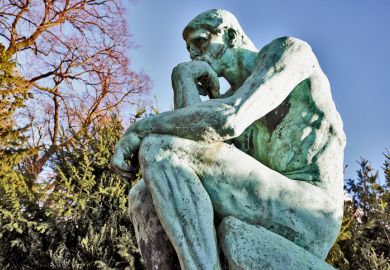What is in a name? Quite a lot if you are an archaeologist, even more if a member of the European Association of Archaeologists. Founded in 1993, the association adopted a new title for its journal in 1998, when the Journal of European Archaeology became the European Journal of Archaeology .
This relaunch, to borrow an increasingly politicised term, is a timely and welcome development, but not without problems. The shift to publisher Sage reflects the association's aspirations to reach and influence the larger international archaeological community. This new mood, as John Chapman's editorial in volume one, number one of the EJA says, is captured in a higher level of academic content, and the title. Although the editorial also claims a new look, the cover remains the same - a white and blue banded affair with the de rigueur circle of 12 gold stars. Apart from a change in emphasis, discussed below, the major change appears to be the frequency of publication - previously twice, now three times a year.
In one sense this change is a sign of the times. Cultural relativity, comparison, sensitivity to gender, heritage and ethical issues coalesce into broad interdisciplinary investigations - and are especially relevant to a Europe undergoing rapid change and still wracked by bitter ethnic conflict. Where a journal of European archaeology may have seemed constraining (if only in name), a European journal of archaeology suggests wider intellectual horizons and the freedom to embrace a diversity of topics and perspectives on a transnational scale.
The heart of the matter nevertheless is content. As its own publicity flier says, the EJA includes not only new data and interpretations, but also debates on the role of archaeology in society and the ethics of practice. It is a delicate balancing act to make this truly of pan-European interest and significance and yet not restrict it to political and theoretical issues of only European concern. At the same time, it should not be a dumping ground for more "traditional" papers that do not make it into specialised journals. The EJA has to appeal by carving out a distinctive identity - a process that will inevitably take time.
Broadly speaking, the last two issues of the JEA are composed of well-defined specialist articles, focusing on such topics as Maltese dolmens, rock art of Portugal's Coa Valley, and Bronze Age and Neolithic economies. The papers are good, but could equally well have appeared elsewhere, suggesting the JEA might have become just another publishing opportunity. In retrospect, this jaundiced view is unfair, as these two issues appeared in 1997, the year of transition towards the new journal. Closer inspection shows that several contributions - on aerial archaeology and European landscapes by Martin Gojda, and the lifecycle of towns from antiquity to the present by John Bintliff - presaged the new orientation of the EJA .
The first three issues of the EJA display an increasing concern with pan-European issues: national identity, archaeological practice and political history. While issue one is virtually indistinguishable from the old JEA , issue two contains several articles that one hopes are an indicator of future directions. Margarita D!az-Andreu explores the issue of how ethnicity is constructed, using Iberia as a case study. Laurent Olivier investigates the tensions between modern French archaeology and legislative and administrative structures inherited from the wartime Vichy regime (1940-44). He illustrates how Petainism drew structural parallels between the incorporation of Gaul into the Roman empire and France's projected future in a German-dominated Europe.
It is, however, in issue three that we first see a majority of articles that collectively serve to move the journal forward. Willem Willem's magisterial paper on trends and developments in European archaeology and heritage management stands out. He addresses complex topics, such as the competing pressures of legislation, finance, green issues, and the role of expert committees in advising the European Parliament and Commission. Central to the debate is national identity as a crucial aspect of the past: how can we resolve the conflict between an homogenised past for superstate Europe and the multiplicity of pasts that lie behind the various nation states of the EU? And how does the effective management of the physical vestiges of these pasts fit into this?
Lotte Hedeager's article on the endurance of pagan cosmological identities in early Christian Europe, and Przemyslaw Urbancyzk's account of the Goths in Poland, also resonate with wider concerns other than those of their specialist audiences. Equally significant is the account of the World Archaeology Congress's inter-congress on the destruction and conservation of cultural property, held at Bracy, Croatia in May 1998.
In the future, we are promised thematic issues and guest editors. This is a real opportunity. In a newly expanded Europe this could be a crucial step in stimulating and enriching the discipline. The varied archaeologies of war are obvious candidates.
Modern archaeology developed out of an earlier antiquarian tradition, was informed by the colonial experience, and came of age during the 19th century, when Europe was busy defining itself as member states. Yet these national styles and traditions often perverted archaeology's aims for non-scientific ends. Once again Europe is defining itself anew, and the psychological if not cultural impact of the millennium is beginning to be felt. From this perspective, the EJA is a publication of its time - an ambitious, hugely symbolic, and eminently worthwhile endeavour. To a greater extent than any other European archaeological journal, the EJA is an integral part of the very processes whose influences it is trying to assess.
Nicholas J. Saunders is lecturer in material culture, University College London.
European Journal of Archaeology: (three times a year)
Editor - John Chapman
ISBN - ISSN 1461 9571
Publisher - Sage
Price - £35.00 (individual ); £105.00 (institutional)
Pages - -
Register to continue
Why register?
- Registration is free and only takes a moment
- Once registered, you can read 3 articles a month
- Sign up for our newsletter
Subscribe
Or subscribe for unlimited access to:
- Unlimited access to news, views, insights & reviews
- Digital editions
- Digital access to THE’s university and college rankings analysis
Already registered or a current subscriber? Login



